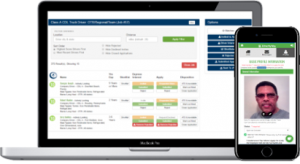
The Great American Trucking Show is over for another year and the excitement of this great annual event, done. For me, this year’s event was personally gratifying. For the first time, I was a featured speaker in the Health Pavilion. Thanks to Rick Ash of Trucking Solutions Group and Randall-Reilly for inviting me to participate in this year’s event. I had a great time.
Another Year at GATS
This year’s show was very special for me. I was given the opportunity to participate in the Health Pavilion as a nutritionist in the trucking industry and share my knowledge with all of the wonderful people who heard me speak. I gave two talks, one about controlling Type 2 Diabetes with diet and another about losing your job due to government regulations on the health of CDL permit holders. Afterward, I opened it up for questions so people could ask me about the ketogenic lifestyle and all it has to offer.
I have had the privilege of attending the Great American Trucking Show for the last few years. I am amazed at the growth of the Health Pavilion since its beginning just a few short years ago. It’s a testament to the hard work and dedication of the people who have worked to make it a reality. Along the way, they have raised awareness for health problems among truck drivers and given truckers valuable tools to live healthier on the road.
Each booth in the pavilion offers something useful for the health of the trucking community
This year, nurses were on hand to take blood pressure, give back massages and offer lotion to alleviate joint pain. Women truckers received free mammograms. A DOT-certified physician gave free physicals so drivers could update their DOT medical cards. And there were a host of healthy giveaways too numerous to count.
The rest of the Great American Trucking Show was just as fabulous
Down on the main floor next to the Pride and Polish Truck area was my team at the Drive My Way booth hard at work. Truck drivers spun the wheel for a snack of some sort. (Too bad none of the snacks were ketogenic. I need to talk to them about that.) I hope to see all of you there next year, with healthy snacks and all.
Like this story? Like our Facebook page here to receive Drive My Way’s content in your newsfeed.
The Ultimate Guide for Truck Drivers to Maintain 3 Healthy Habits Over the Road
Download the complete guide for tips to easily maintain healthy habits over the road.




 Mosquitoes have always been a summer reality, but with the advent of the Zika virus and the West Nile virus now endemic in California, their dangers suddenly seem to loom larger in today’s world.
Mosquitoes have always been a summer reality, but with the advent of the Zika virus and the West Nile virus now endemic in California, their dangers suddenly seem to loom larger in today’s world.





 a lot you can choose from, depending on your own personal tastes. Any of the following foods will do, and it’s just a sampling: Eggs, raw nuts, bacon, olive oil, coconut oil, heavy whipping cream, real butter, meat, fish and steamed vegetables (except root vegetables). The fattier the better.
a lot you can choose from, depending on your own personal tastes. Any of the following foods will do, and it’s just a sampling: Eggs, raw nuts, bacon, olive oil, coconut oil, heavy whipping cream, real butter, meat, fish and steamed vegetables (except root vegetables). The fattier the better. We all know the main addictions: Nicotine, alcohol and narcotics. But what about that other addiction we don’t hear as much about? If you can’t go down the candy or snack cake aisle without grabbing a treat for yourself, if you eat so much you have to unbuckle your pants just to breathe, let’s face it. You have a food addiction.
We all know the main addictions: Nicotine, alcohol and narcotics. But what about that other addiction we don’t hear as much about? If you can’t go down the candy or snack cake aisle without grabbing a treat for yourself, if you eat so much you have to unbuckle your pants just to breathe, let’s face it. You have a food addiction.
 Drive My Way has a new health columnist. He’s a longtime driver who’s had a
Drive My Way has a new health columnist. He’s a longtime driver who’s had a 




 People with CDL trucking jobs already lament the federal regulations they must abide by in today’s world. Now, yet another regulation looms in the balance for truck drivers. If you are a CDL permit holder, now’s your time to speak up on the issue of sleep apnea.
People with CDL trucking jobs already lament the federal regulations they must abide by in today’s world. Now, yet another regulation looms in the balance for truck drivers. If you are a CDL permit holder, now’s your time to speak up on the issue of sleep apnea.
